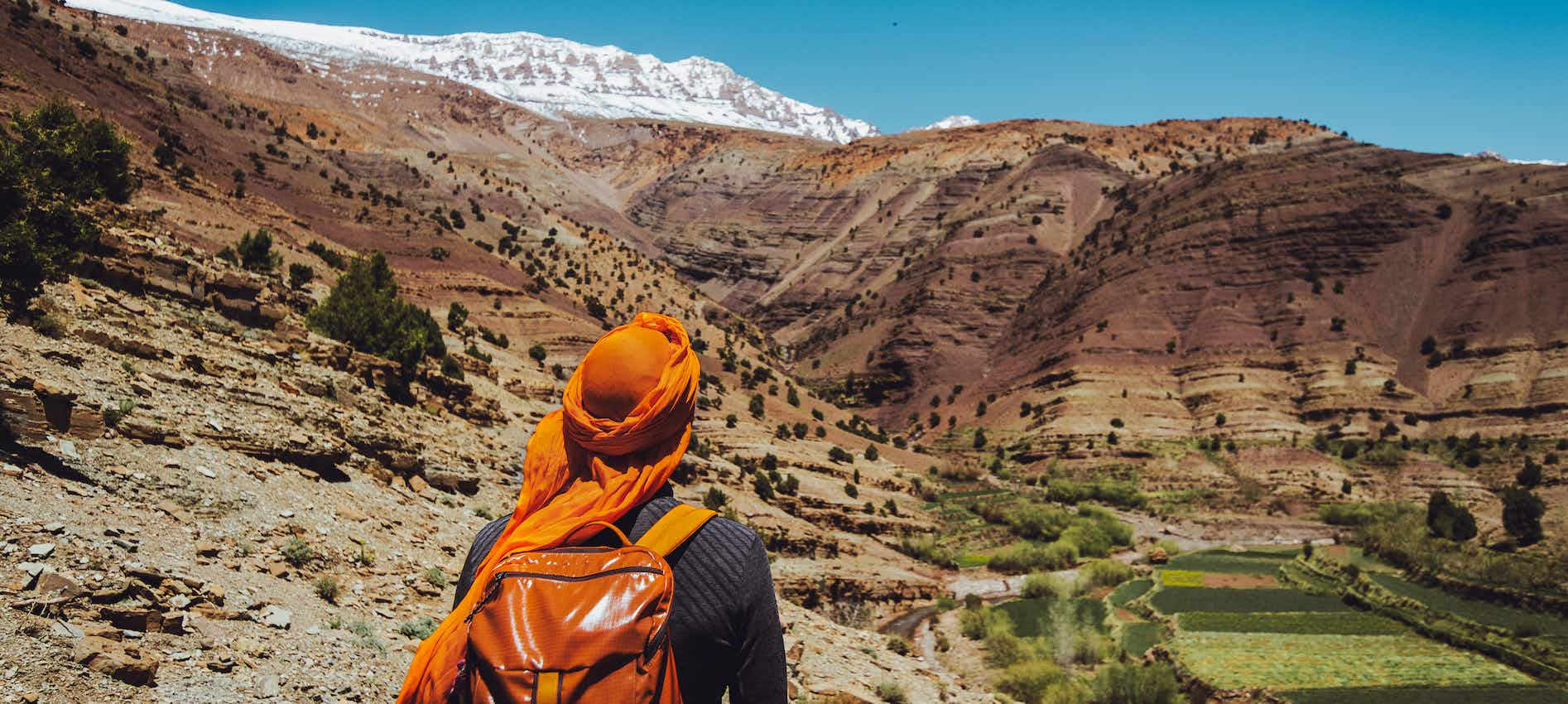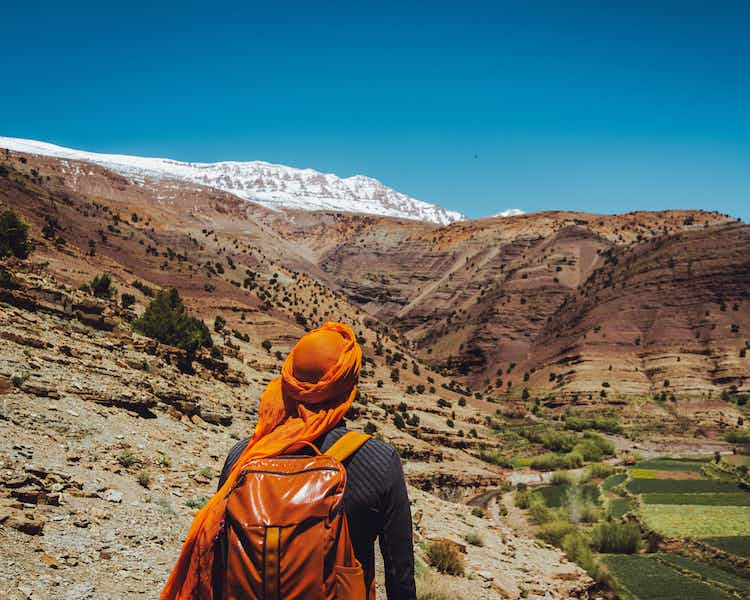Your guide will meet you at the airport and escort you to your accommodation in Rabat. If time allows, you can go for a self-guided tour of Casablanca and visit the Hassan II Mosque, Mohammed V and United Nations squares, Notre-Dame-de-Lourdes church with its stained glass windows, the residential district of Anfa, and Ain Diab Corniche. You will enjoy lunch at a local restaurant followed by a drive to Rabat, the administrative capital of the kingdom, and visit the Royal Palace, the Oudaya Kasbah, Mohamed V Mausoleum and Hassan Tower (XII century).
After breakfast, you will enjoy the scenic drive to Chefchaouen and see the landscape transform as you approach the Rif mountains. Chefchaouen, or simply “chaoeun” by the locals translates to “two horns” named for the two peaks rising above the hillside town. To travellers, it’s mostly known as “The Blue City”, offering an endless winding maze of picturesque homes and streets. You’ll notice quite a difference from the Medinas of Fes and Marrakech, with a much more relaxed atmosphere and some of the friendliest people you will find in the country!
In the late 15th century the population was boosted by a number of Jews and Muslims fleeing southern Spain, and it has remained mostly untouched and isolated until the last century. You will spend most of your time in the compact Medina area, which clings to the northern hillside. Lose yourself and wander through the small alleys and roads. At the bottom, you will find the Plaza Outa el Hammam, the main square named for the number of Hammams which used to circle it. Here you will find many restaurants and cafes for people watching, and several shops to browse in. You may wish to spend more time in these shops than in Fes or Marrakech, as the prices are more reasonable and shopkeepers may not be as pushy. Here you will also see the Grand Mosque and Kasbah. The Mosque was built by Moulay Mohamed in 1560 and cannot be entered by non-Muslims (but the view from the outside is still worth it). A visit to the Kasbah can be done in 30-60 minutes, where you can visit a garden, a museum, and some of the old prison cells. Head up to the roof for a better viewpoint on the town. Keep walking up and you will eventually reach the city walls, which have a few gates. Continue up the paths towards the Hotel Atlas and you will be rewarded with a vast view over the blue city. As the day ends, follow the streets east and you will pass over the Ras el Ma spring, where the Oued el Kebir river flows below the town. A couple of nearby cafes are a nice place to enjoy an afternoon mint tea. Follow the path up the hill for 20-30 minutes and you will arrive at the white Spanish Mosque. From here you can enjoy one last view over the town as the sun sets behind the mountains.
In the morning you will depart for Fez. On the way there, you will visit the archaeological site of Volubilis, an ancient Roman city: the Gallien baths, the forum, the Capitol, the basilica, the triumphal arch and the villas which still have well-preserved mosaics. Continue to the Holy City of Moulay Idriss, perched on a rocky promontory. Then, visit of Meknes, the former capital of Moulay Ismaïl, protected by its monumental gate, the mausoleum of Moulay Ismaïl (subject to reopening) and the remains of the attics. You will then continue on to Fez.
The full day is dedicated to the religious capital of Morocco. There are panoramic views of this splendid site from the South Borj or the North Borj. Then you will visit Fez el-Jdid and its mellah (former Jewish quarter), doors of the Royal Palace. Discovery of the unique atmosphere of the medina of Fez el-Bali: Bou-Inania and Attarine medersas (subject to the medersa bring open), Karaouiyine Islamic University, Nejjarine fountain, souks, Nejjarine museum of arts and woodworking. Lunch will be in an old palace in the medina. You will have some free time here and dinner in a local family home, an opportunity to taste some local specialties made by the Fassis family.
In the morning, you will head for the Merzouga desert. The road passes through the fabulous Tiz Ntalghamt pass and crosses the Ziz Valley, which offers impressive panoramas on the High Atlas Plateau. As you approach the town of Errachidia, you will notice how the landscape gradually changes to give way to the desert. Lunch will be in Errachidia, where you will appreciate Berber hospitality. You will then cross the lush Ziz Valley, stopping from time to time to enjoy the magnificent panoramas. You cross Erfoud, then Rissani, before arriving in Merzouga in the afternoon. Take a short break near Merzouga for a camel ride through the dunes; you'll arrive at camp just before sunset. Climb up the nearest sand dune to watch the colorful display on the sand sea as the sun dips in the west, then head back to camp for dinner, followed by an evening of traditional Berber music by your campfire. Before you head to bed, take a look at the expansive night sky, then turn in for the night in your traditional Bedouin tent.
Today you will enjoy a drive through the dunes of Erg Chebbi by Jeep to discover the hidden secrets of this magical land; meet with the Berber desert nomads and enjoy a cup of tea with a local family, visit the Gnawa house in Khamleya village to explore the spiritual healing music; Traditionally practiced throughout Morocco and originating from the sub- Saharan region, Gnaoua music is a spiritual music at its roots, although popular maâlems (master musicians) are making the music quite mainstream. Headed by a maâlem with a group of musicians and dancers, the beats are repetitive yet lively. Afternoon, you can rent a sand board and test your skills on the dunes. Late afternoon, climb up the nearest sand dune to watch the colorful display on the sand sea as the sun sets to the west, then head back to camp for dinner and a night by the campfire enjoying traditional Berber music from the locals. Before you head to bed, take a look at the unhindered night sky.
As you leave the Merzouga region, you will stop in Rissani, another market town with an impressive gate at the entrance. It is a good place to take a walk around a traditional market, especially on market days. The route offers beautiful views of the region and the khettara (irrigation systems). In Lalla Mimouna, visit of the Sources museum for an overview of Berber culture. Upon entering, visitors are invited by a harmonious progression of the place, to browse the aisles of all that is representative of the local history and of both Berber and nomadic life.
Let yourself be guided along the signposted route while inhaling the scents of the groves of Ibiscus, laurels or bougainvilleas planted by the owner of the place. A great lover of maxims and an attentive calligrapher, Zaïd collects all kinds of enlightened quotes on water. They appropriately dot the various stops along this pilgrimage evocative of a return to basics. Reach the the village of Tinerhir, former ksar of the Todra valley, neighbour of the old kasbah of Glaoui. Excursion to the spectacular Todra Gorge Continue to the mountain town of Boumalen Dades for an overnight stay.
Morning drive through the road of Thousand Kasbahs, time to explore the city of Qelaat Mgouna , a small town located between Ouarzazate and the Sahara Desert and capital of the valley of roses. If you visit during the first week in May, you can observe the annual rose festival There is never a set date for the festival as it depends on the harvest season. Expect a lot of local Berber musicians playing traditional instruments and dancing. Continue towards Ouarzazate, which was in the past the point of commercial and cultural encounters between different peoples of the North and South of the African continent. Visit of Aït Benhaddou, the most famous Kasbah in Morocco and a UNESCO world heritage site, it has been featured in many movies, portraying landscapes all over the desert, Africa, and the middle east. Some popular film credits include Lawrence of Arabia, The Last Temptation of Christ, Alexander, Gladiator, Black Hawk Down, Prometheus, American Sniper, and Game of Thrones.. People believe that the old Ksar dates from the 11th century
when it held an important position along the trans-Saharan trade route between Marrakech, Ouarzazate, and the southern desert. Route via the Tichka pass (2260 m altitude) to Imlil, the starting point of hikes to the Toubkal summit. After a short walk, reach your mountain lodge and prepare for your two day hiking adventure at the heart of the Toubkal National Park.
The village of Imlil welcomes you, surrounded by the impressive mountains of the High Atlas. The highest summit is at 4,168m meters and the average altitude of the valley is 1,800 meters. This particular geographical situation makes this village very special. You will be helping the Moroccan Berber population by assisting dedicated men and women whose aim is to allow the villagers to fulfill their dreams. Educational, cultural and medical projects will help them progress and improve their actual and future quality of life. You will help tackle the lack of schooling, education and training of young people in several areas such as:
Improve the rural populations' sanitary conditions
Promote environmental protection
Enhance the cultural, architectural and historical Moroccan heritage
Promote Berber culture and art
Fight illiteracy
Develop organic farming
You will start the trek between the fields and surrounding villages of Imlil along the Ait Mizane valley, Tagadirte and Armed at 1,900m, then into the shrine of Sidi Chamharouch, at 2,500m with your lunch next to the river. Following this you will continue to climb steadily to the Toubkal refuge at 3,207m through snaking and zigzagging mule tracks. You will stay overnight at the refuge.
The next day is an early start to catch sunrise from the summit of Toubkal, passing by the river into the south circle and climbing through of boulders and rocks (it’s a challenging walk rather than a climb) before reaching the plateau from where you can enjoy the first of the sunset on the surrounding peaks above 4,000m. There's a short walk to the summit with a panoramic views on each side of the mountain before you will finding yourself on the top of north Africa, a beautiful view in every direction (to the north the plain of Marrakech and the northern valleys, lake villages, to the south, Anti Atlas & Sahara). Time spent at the top will depend on the weather, approx. 30 minute will be enough before descending same way to the refuge which takes two hours, lunch/rest then approx three hours walking down to Imlil to head to Marrakech.
In the morning we visit the Koutoubia Mosque from the outside. The "Mosque of the booksellers" from the 12th century is the oldest mosque in Marrakech and one of the oldest in Morocco. Also, in the morning we visit the Saadian graves from the 16th century. Seven sultans and over 60 other Saadite members were buried in this necropolis. The mausoleums are richly decorated with filigree stucco work, fine mosaics and artistic carvings made of cedar wood. Continue to the Bahia Palace on an area of 8,000 m2, which the Grand Vizier Si Moussa had built in 1867 and which his son Bou Ahmed added a garden, a hammam and a mosque. In the shady, planted inner courtyard of the palace, the combination of pomp and structural lightness is particularly impressive. After lunch we venture into the labyrinth of souks in the medina and let our
senses bewitched by smells, colors and sounds. The long stroll through the winding and busy alleys ends at the Djemaa el Fna square. At this pulsating meeting point for traders, jugglers, monkey dressmakers, musicians, dancers and storytellers, we once again immerse ourselves in a world of 1001 nights. The medina of Marrakech with the Djemaa el Fna square and the Menara and Agdal Gardens has been a UNESCO World Heritage Site since 1985. Afternoon horse carriage ride through the city and visit of the historic botanical Majorelle gardens, which the French painter Jacques Majorelle had laid out based on the model of the palaces of Marrakech, dating from the 1920s. It is about two km northwest of the medina. Here you can marvel at playful watercourses and tropical plant art with cacti and bamboo from different climate zones. Also, worth seeing is the former “blue studio”, which today houses the Islamic Art Museum.
Depending on your flight time you may have more time to explore the city, or you can drive straight to the airport.


















